Kurukulla: the “Diva” Dakini of enlightened magic; the enchantress transforms seduction into ‘the cause of wisdom’
Buddha Weekly: Buddhist Practices, Mindfulness, Meditation. Copyright Buddha Weekly.
Kurukulla could be thought of as the “Diva” pop star of the Dakinis. She is like a beautiful, modern celebrity endorsing a worthy cause; she projects this divine and Enlightened beauty to attract us to the Dharma. She uses her enchanting “magic” to remove our obstacles to practice. We all need a little enchantment in our lives, don’t we?
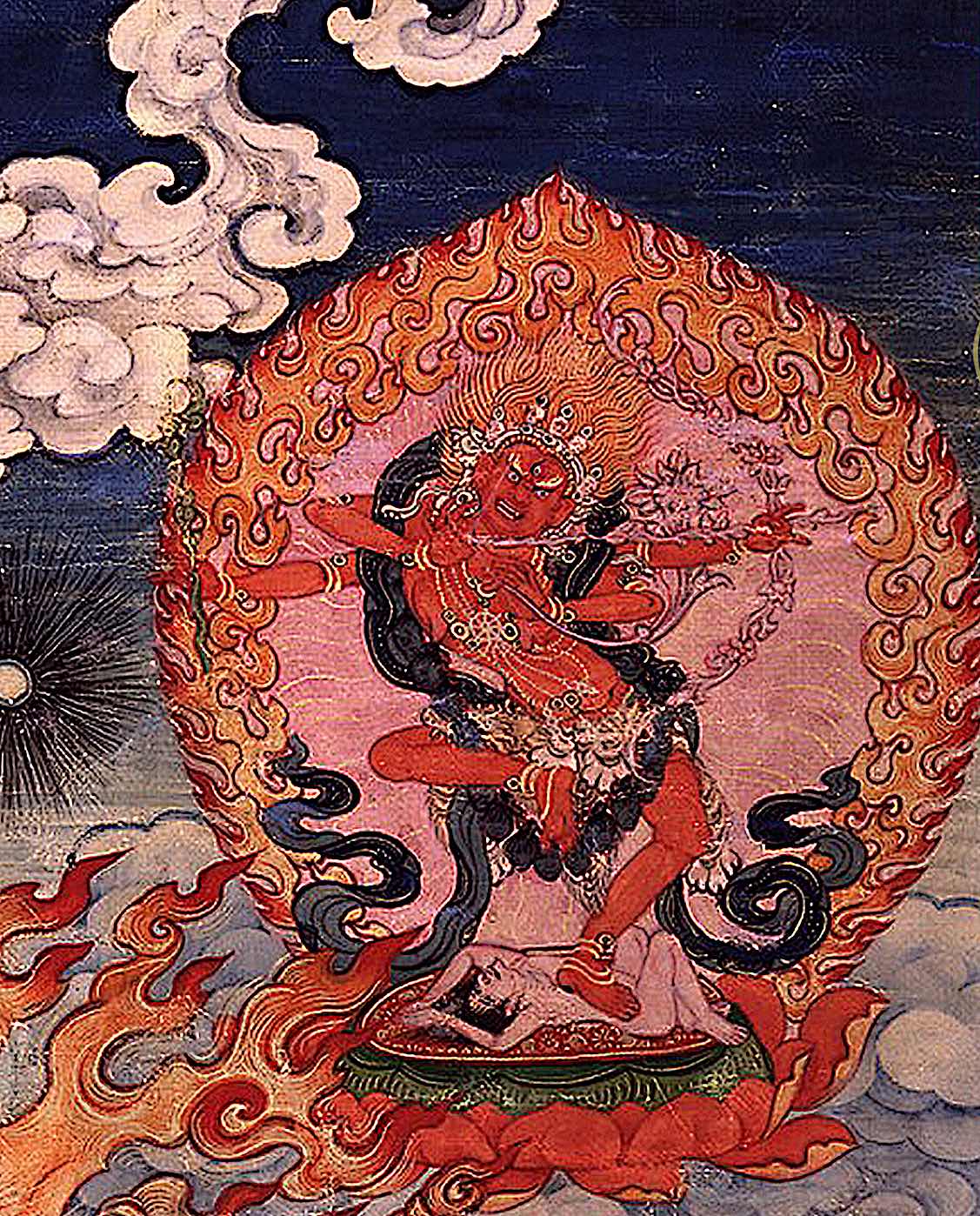
Kurukulla is the “enchantment” aspect of Tara. EVENT Notice: Kurukulla initiation with H.E. Zasep Rinpoche in Toronto>>
She is as popular today, as she was hundreds of years ago. As a Dakini, a Higher Tantric practice, she is the “very cause of wisdom” — her Tibetan name Rigiyedmna (རིག་བྱེད་མ) literally translates as “she who is the cause of knowledge”. Although she has her own tantras and practices, she is considered an emanation of Tara: Tarobhava Kurukulla, “the Kurukulla who arises from Tara” (Red Tara: sgrol-ma dmar-po.)
“Culmination of the pristine awareness and compassion of all conquerors,
Well arising as the bliss-emptiness – Goddess of Power,
Controlling all beings of the three realms with a charming form;
Homage to the Dakini.”—Nyingma liturgical verse [1]
“Magical” aspect of Tara
Everyone loves a little magic. Kurukulle is all about the enchantment. Like other emanations of Tara, who might use their divine beauty to attract and influence, Kurukulla embraces this concept, but to an erotic extreme. However, it is likely the exotic “magical” and miraculous aspects that have kept Kurukulla, the Passionate Lotus Dakini, popular both today and in past centuries. Although she is often associated with “attraction” and “magnetizing” — an overall aspect of the red Lotus family of Amitabha, Chenrezig, and Hayagriva — she is not a mundane deity. Despite depictions of her magnetizing powers as “magical,” they are not for the corrupted purpose of attracting a mate, or money, or luxuries.
Like other emanations of Tara, she is about the “activities” of compassion, in this case attracting and enchanting. And, like all Taras, this is a skillful means to help us remove obstacles in our own practice, by attracting good fortune to the Sangha, or to the practitioner. With a virtuous, Bodhichitta goal, her practice can have the virtuous aspect of creating auspicious conditions for practice.
Special Event Notice: On November 30, 2018, for those in the Toronto area, there will be a rare empowerment (initiation) of Kurukulla from H.E. Zasep Rinpoche at Gaden Choling Mahayana Meditation Centre. Details here>>
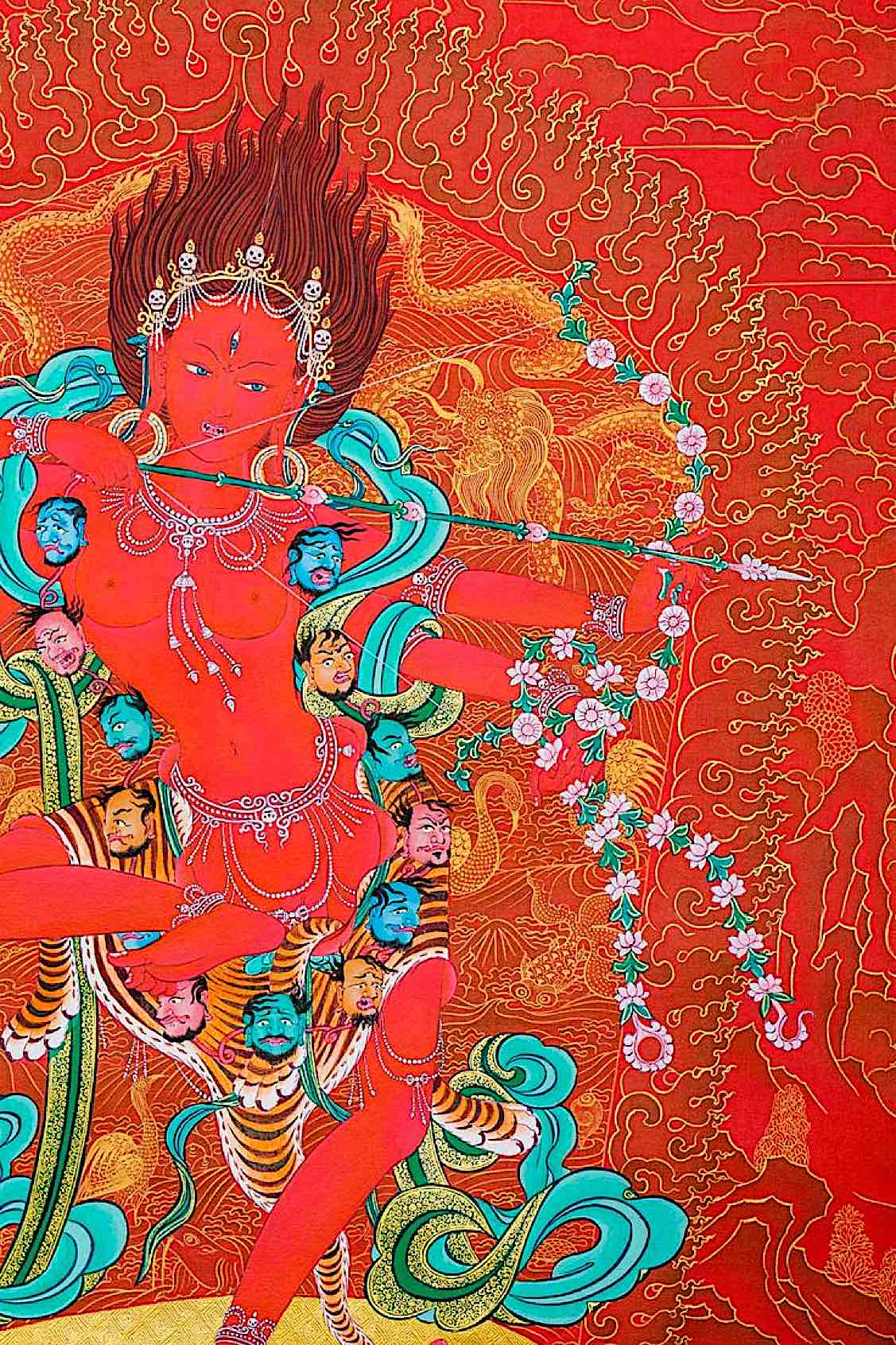
Kurukulla is the most beautiful of the Dakinis. As a Dakini of the Padma family, she represents Dharma and Speech. One way to understand her seductive appearance is as a symbol of the “attractiveness” of the Dharma. Her name literally translates as “she who is the cause of knowledge.” Her bow and implements are made up of red Uptala flowers, sacred to Tara and the Lotus Family of Amitabha, symbolizing compassion.
The cult of beauty: Kurukulla
The cult of beauty is well established — with beautiful people, actors and models drawing us in immediately with their presence. Using this beauty and magnetism for the Dharma cause, Bodhichitta, Metta and Compassion, is the very definition of the “diva” Dakini Kurukulla.
Colour is the clue in deity visualizations. Generally, there are five colours corresponding to a different characteristic or aspect. For example, with Tara emanations we have:
- Red: Kurukulla and/or Red Tara (some traditions separate them) — attracting and magnetizing (in older language “enchanting); in other words creating auspicious practice by attracting helpful conditions.
- Green: Green Tara! Tara’s most popular emanation is green is the colour of “wind” and “activity.” We rely on Green Tara for speedy response, safety, protection, help in time of need.
- White: White Tara — calming and pacifying and healing (in older language “long life practices”); in other words creating auspicious practice by attracting helpful conditions for a long life.
- Yellow: Golden Tara (Yellow Tara) — creating the karma for auspicious wealth, knowledge, merit and support to streamline our practice.
- Black: Black Tara (yes, there are black Taras!) and many Dakini manifestations. Black is about removing obstacles, obliterating issues (in older language “subduing evil or demons”) and creating the conditions for good practice by removing our stresses, doubts, obsessions and other obstacles.
The reason for Kurukulla’s popularity is clear. Attracting auspicious conditions is always enticing. But, how does the “magic” work?
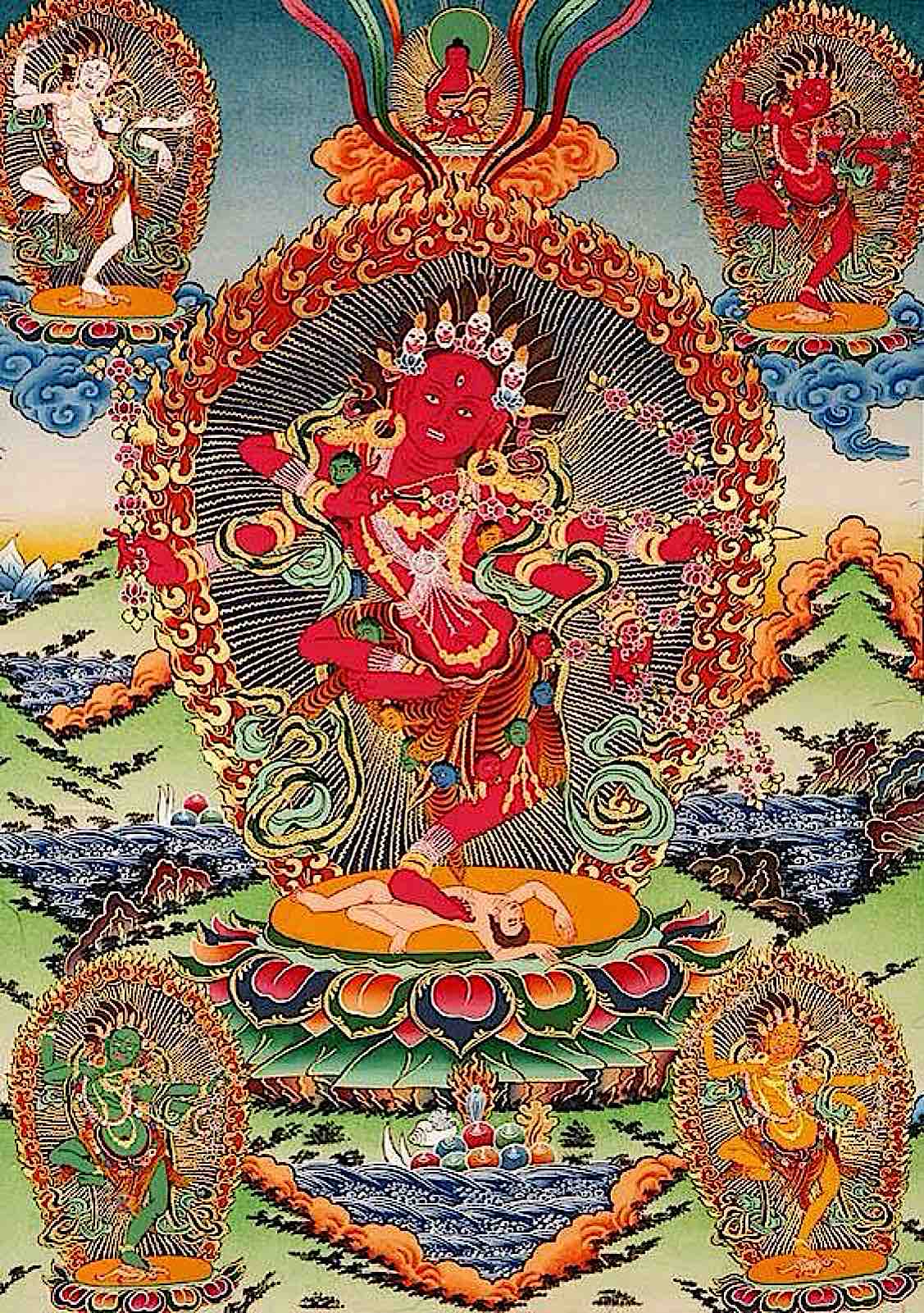
One of Kurukulla’s mandalas with five colours of Dakini.
Magic is, well, magical
In a recent feature in Buddha Weekly “Is here room for the supernatural in Western Buddhism,” the author begins:

Kurukulla is the “enchantment” aspect of Tara. EVENT Notice: Kurukulla initiation with H.E. Zasep Rinpoche in Toronto>>
“Does removing the magic from Buddhist practice seem less — magical? Sometimes, with a secular approach to Buddhism, we strip away some of the flair, the near euphoric joy of the Buddha’s Dharma. That “bliss” can be an important part of practice, especially in Vajrayana. Even Tantric Buddhism, with all its supernatural wonder and magical “taste,” is reduced — by many modern practitioners — to “symbolic archetypes” and mind-states. In the West, many — perhaps most — Buddhists like to turn their backs on a term like “metaphysical” or “religion” and refer to the Dharma instead as philosophy and method.”
The feature goes on to describe the four views of “magic” in Buddhism. The four views could be described this way:
• View 1: The supernatural or metaphysical is unimportant: In Cula-Malunkyovada Sutta, Buddha refused to answer questions of a Metaphysical nature. Why? Because they are “not important” to the path to Enlightenment.
• View 2: The complete opposite, that deities, magic and the metaphysical are subjectively real: For those who embrace the wonder of the labelled, including supernatural labels, this is just another relative aspect of what we perceive to be a reality.
• View 3: They are symbolic or metaphorical: Buddha would have spoken in terms commonly used in his day. It’s easier to say “Brahma” — as he did explicitly in Brahmajala Sutta — than to say “creative force.”
• View 4: That all phenomena are ultimately non-dual — or as is often said, “not two” — perceptual, rather than tangibly “real,” and from this view, all are “aspects” of a One-ness.
Whatever, our view of “magic” and the “enchantment” there is no doubt it works from the view we accept. Whether it’s intention working on our minds to change our conditions, or some metaphysical force — ultimately, they are “not two” as the Zen Buddhists say.
Kurukulle’s enchantment works at one level, or the other.
Enlightened magic: Bodhichitta required
Her power to attract, magnetize and mesmerize is an Enlightened mission: if money, a suitable mate or knowledge and power will contribute to the “cause for Enlightenment for all beings” it is worthy of her blessing. Kurukulla is not — as has been suggested by some early scholars — a “love goddess” ready to bring you love and sex.
Yes, she is voluptuous, seductive and beautiful; and yes, she carries a flower-decorated bow — very similar to the western Cupid — and certainly, she is associated with love and attraction. But this is not a “magic spell” carnal lust type of attraction. She uses her powers of magnetizing to bring conditions favourable to the path to Enlightenment. Without a bodhichitta aim, there is no enchantment.
What is this magical power?
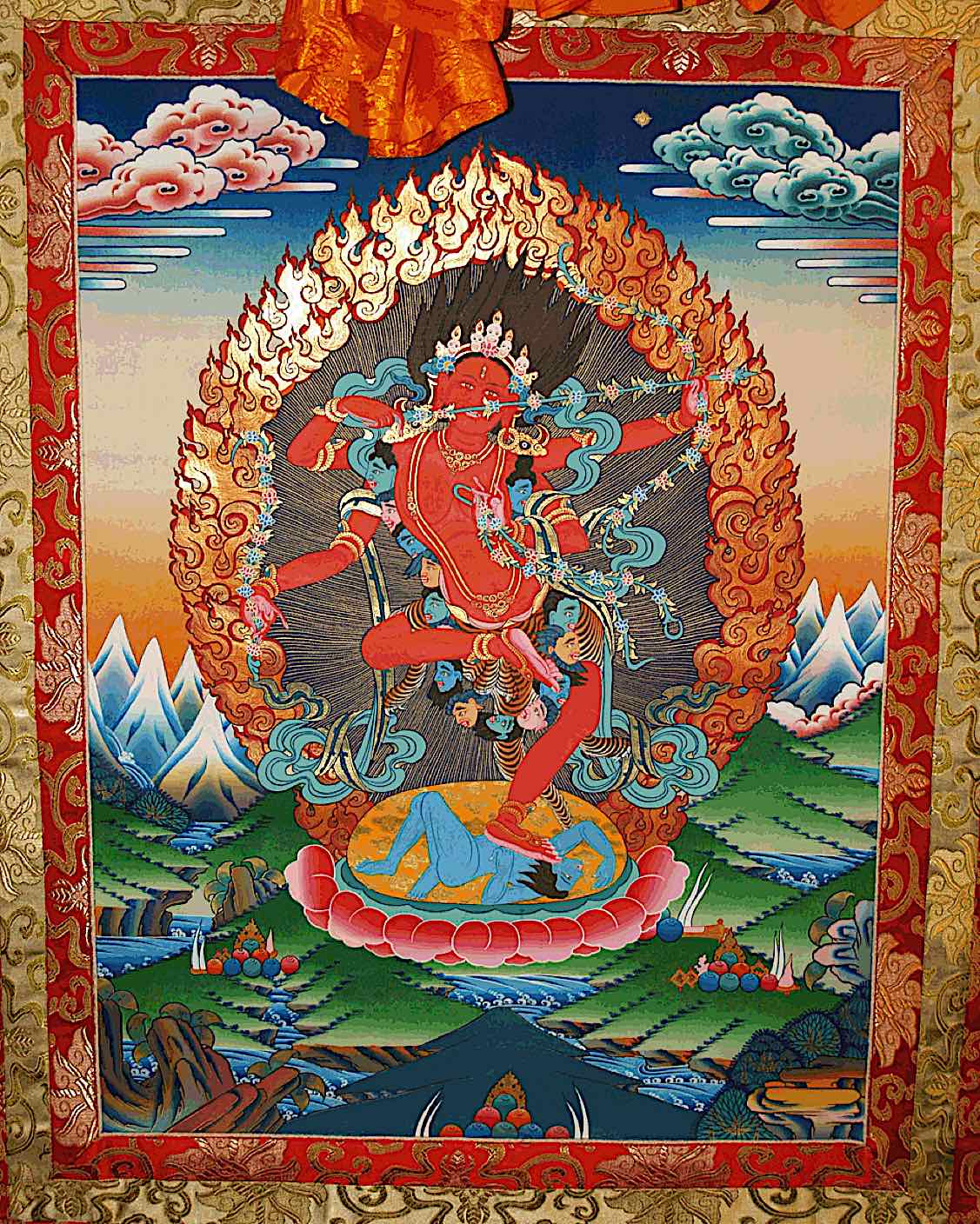
Kurukulla is the Highest-Yoga Tantra aspect of Red Tara.
Kurukulla’s mesmerizing appearance
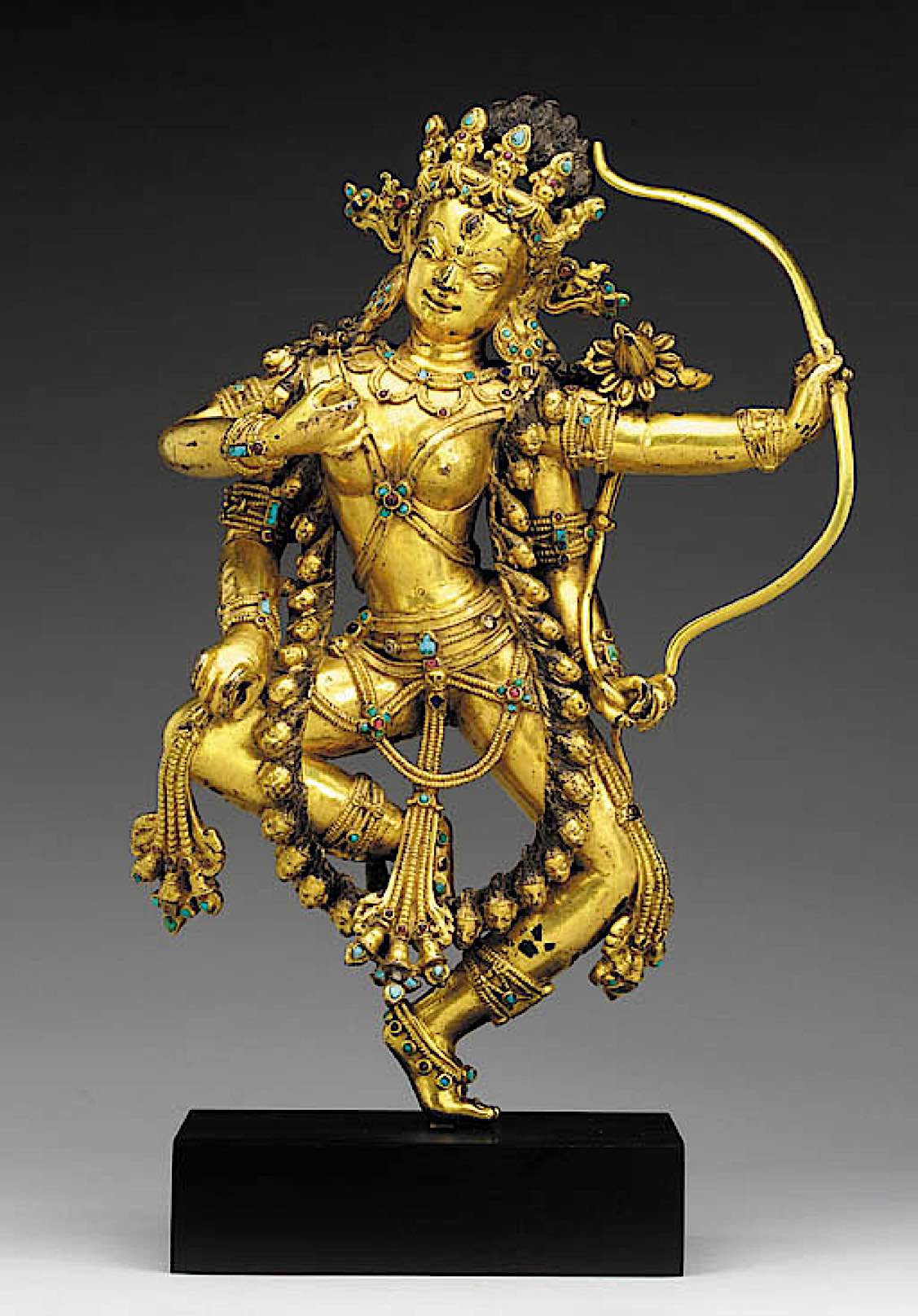
Kurukulla, the Enchantress, transforms seduction into Enlightened wisdom.
Similar to Vajrayogini, Kurukulla’s appearance is voluptuous, vibrant, youthful, energetic, sexual. To represent her magnetizing aspect, and the Lotus family, she is visualized as a body of glowing red light. She dances, as most Dakini’s do, to represent her activity as a Wisdom Goddess, and under her feet is the asura Rahu (the one who devours the sun.)
She has, typically, four arms, although in other aspects eight. She usually holds a bow and arrow made of beautiful flowers in one of her pairs of hands. Her other hands hold a hook and a noose of flowers. As with all Tantric visualizations, an explanation of a teacher is required. The depth of symbolism is profound. She is both an emanation of Amitabha, and also a form of Tara.
Her root tantra is the Arya-Tara-Kurukulle-Kalpa (Practices of the Noble Tara Kurukullā), which was translated by Ts’utr’im jeya, a close disciple of great Atisha.
According to the Himilayan Art Resources, who collect and archive museum-quality Dharma art, she is described this way:
Kurukulle (Tibetan: rig che ma. English: The One of the Action Family): Goddess of Power.
“Slightly peaceful and slightly wrathful in a dark red appearance, she has one face, three eyes, dark yellow hair flowing upward and four hands. In the first pair of hands held upraised is a bow and arrow constructed of red utpala flowers and aimed to the left. The second pair hold in the right a hook and left a lasso. Adorned with a tiara of five white skulls, earrings, and a necklace of fifty heads, she wears a green scarf and a tiger skin skirt. Standing with the right leg drawn up in a dancing posture and the left leg pressing on a corpse above a sun disc and red lotus seat she is completely surrounded by a circle of flames of pristine awareness.
At the top center is Amitabha, the buddha of boundless light, red in colour, seated with the two hands in the mudra (gesture) of meditative equipoise placed in the lap supporting a black begging bowl. At the bottom center are precious offerings of wishing jewels, red coral, and the like, with flower vases standing at each side.” [1]
Self-generating Kurukulla — it is magical
Although some might see a Venerable Kurukulla, suitable for offerings, the real practice with this magnificent deity is Tantra — only, of course, for those with initiation. In Tantra we self-generating as the deity. [For those unaware of this practice, please see our many features on deity practices and seek the advice of your teacher. Self generating any Yidam requires empowerment, permission and teachings.]
Essentially, by visualizing ourselves as Kurukulle, then generating deity pride, we gradually, with each meditation, take on the characteristics and methods of the goddess. Since “magic” is about transformation, and this visualization works at the level of your mind — it literally is magic. The changes occur within our mindstreams. We find people listen to us more (magnetizing.) People find us more interesting (Kurukulle’s sensual nature). We exude compassion, taking on the characteristics of the Padma family over time.
It’s not about controlling others; it’s about controlling our minds. Most importantly, our minds tap into Kurukulle’s guided practice to develop insight into the true nature of reality. After all, Kurukulle, a Dakini, expresses Wisdom.
Self Generation only works under the guidance of a qualified teacher of lineage, who can transmit the full teachings. For those without the empowerment and commentary from a teacher, practitioners should not self-generate. Kurukulle is a wonderful deity to venerate — as with all fully Enlightened deities.
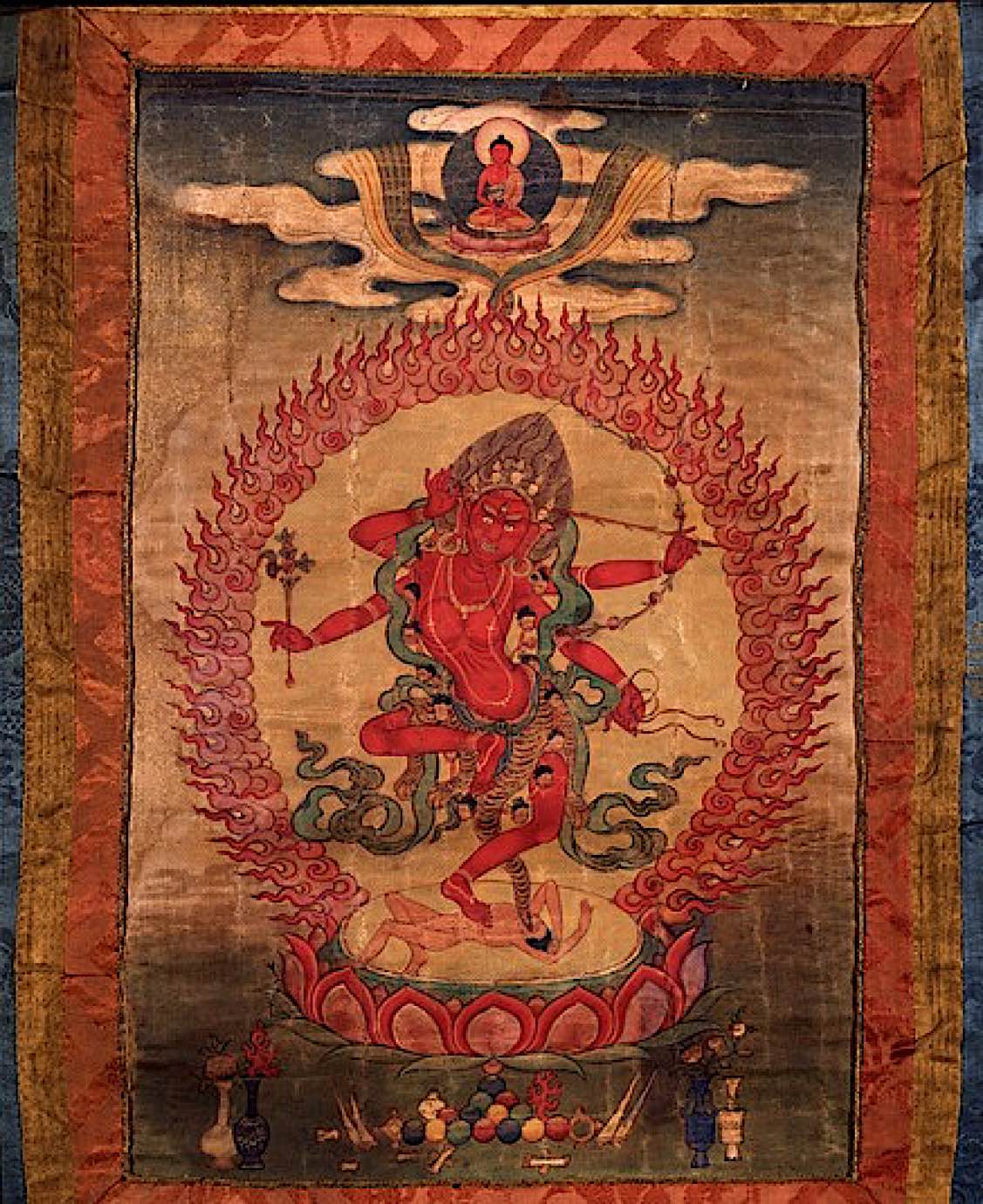
A very old Thangka of Kurukulla.
Whether self-generating, or visualizing in front of us as an object of veneration, she is imagined the same way (although there are different forms.)
“…the Goddess Kurukulla, with a body red in colour, one face and four arms. The first two hands hold an utpala bow and arrow drawn to the ear. The lower right holds a hook that subdues the Three Worlds, the lower left an utpala noose; with short fangs, the face is slightly smiling and slightly angry, with three eyes and adorned with two beautiful breasts, having the youthful form of sixteen years, with brown hair flowing upwards, adorned with five skulls having the nature of the Five Families as a crown, a necklace of fifty fresh heads and five ornaments of bone, wearing a tiger skin as a lower garment, standing on a human corpse with the head turned to the left, with the left leg extended. The toes of the right are placed on the thigh, as in a half vajra [posture] dancing manner, dwelling in the midst of a beautiful circle of sun rays, visible, but not solid, like the form of illusion.” — Ngorchen Konchog Lhundrub (1497-1557). sGrub Thabs Kun bTus, vol.8, folios 528-555.
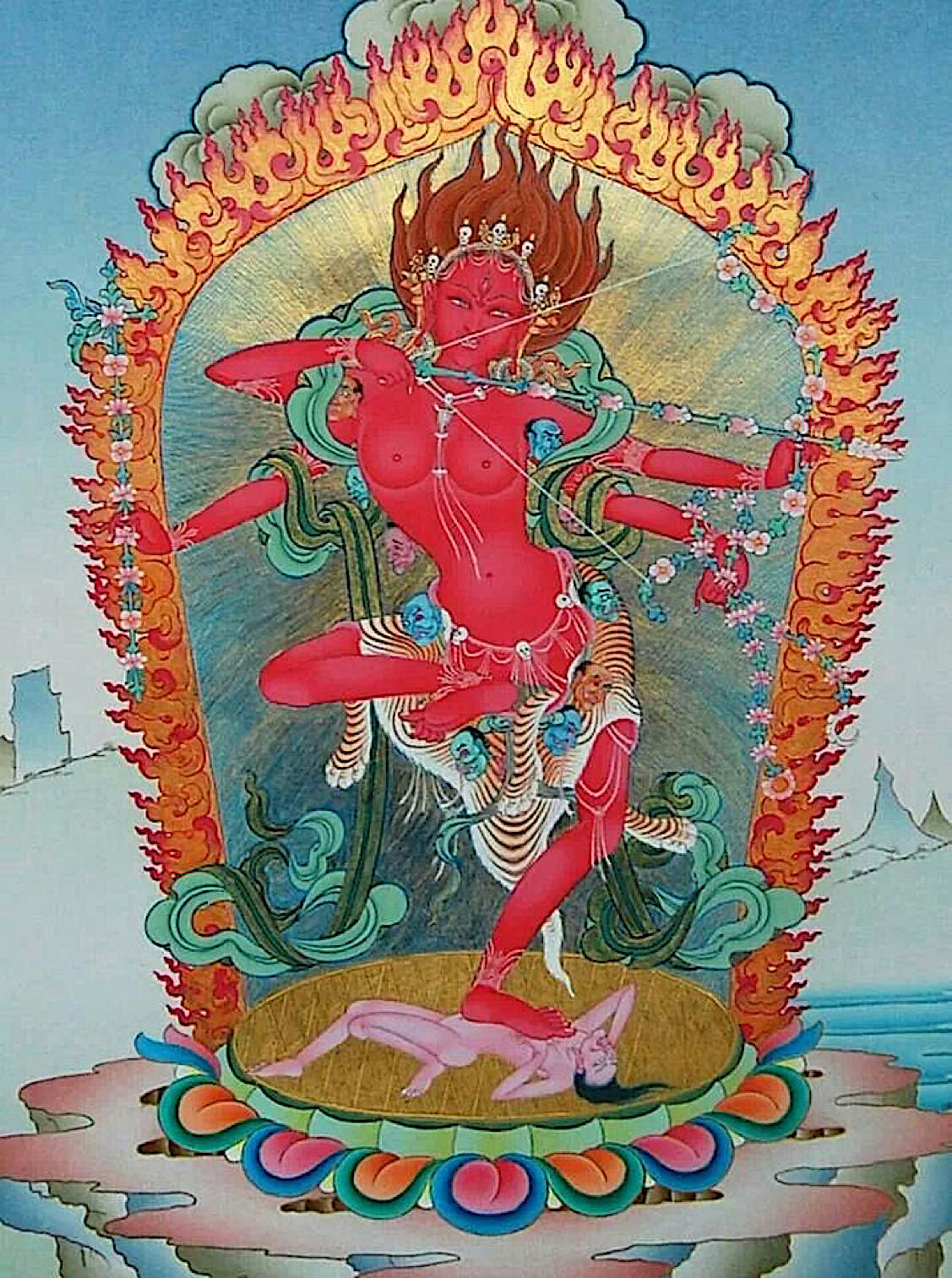
Lovely Kurukulla, embodies attraction: symbolizing the attractive pull of the Dharma.
Details of Form: Symbolism
As with all Tantric Buddhist deities, every post, arm, leg, implement and adornment is a symbol representing profound truth. In the case of four-armed Kurukulla, the most common form:
- Red colour: symbolizes the west, fire, Padma Family, Lotus and notably the “family of Speech” or Dharma.
- Seductive and beutiful: a sixteen-year old youth (in Tibetan Buddhism, sixteen-year-old normally symbolizes youthful vitality), which indicates her power to attract, to mesmerize, to draw-in and enchant followers to her inner Wisdom and the Dharma.
- Red streams of light: emanate from her beautiful form, symbolizing her compassion reaches out to all beings.
- The bow and arrow of red Uptala flowers: red is the Padma (Lotus family) and Uptala flowers are sacred to Tara: like cupid, her power to pierce us with her seductive wisdom.
- Vajra hook (also red Uptala flowers): in her second pair of hands, her right hand holds a Vajra hook (in India, an Elephant Goad) to “hook back” all sentient beings into her compassionate arms
- Lasso: also made of red Uptala flowers in her left hand.
- Dancing: Dakinis almost always appear in “dancing” form. In part, this symbolizes the elusive, playful nature of Emptiness (Shunyata) and the pure joy of Clear Light.
- Left leg stands on top of a prone male — usually indicating subduing our egos. The left leg is always the lead leg in female Dakinis (in Wrathful male deities it is the right.)
- Wrathful adornments: skull crown, garland of freshly severed heads, tiger skin skirt, beautiful silks and necklaces.
Other forms: Kurukulla, depending on lineage and tradition, can also appear in other colours: blue, white, pink, seated, two-armed, six-armed or in a full mandla of 23 deities.
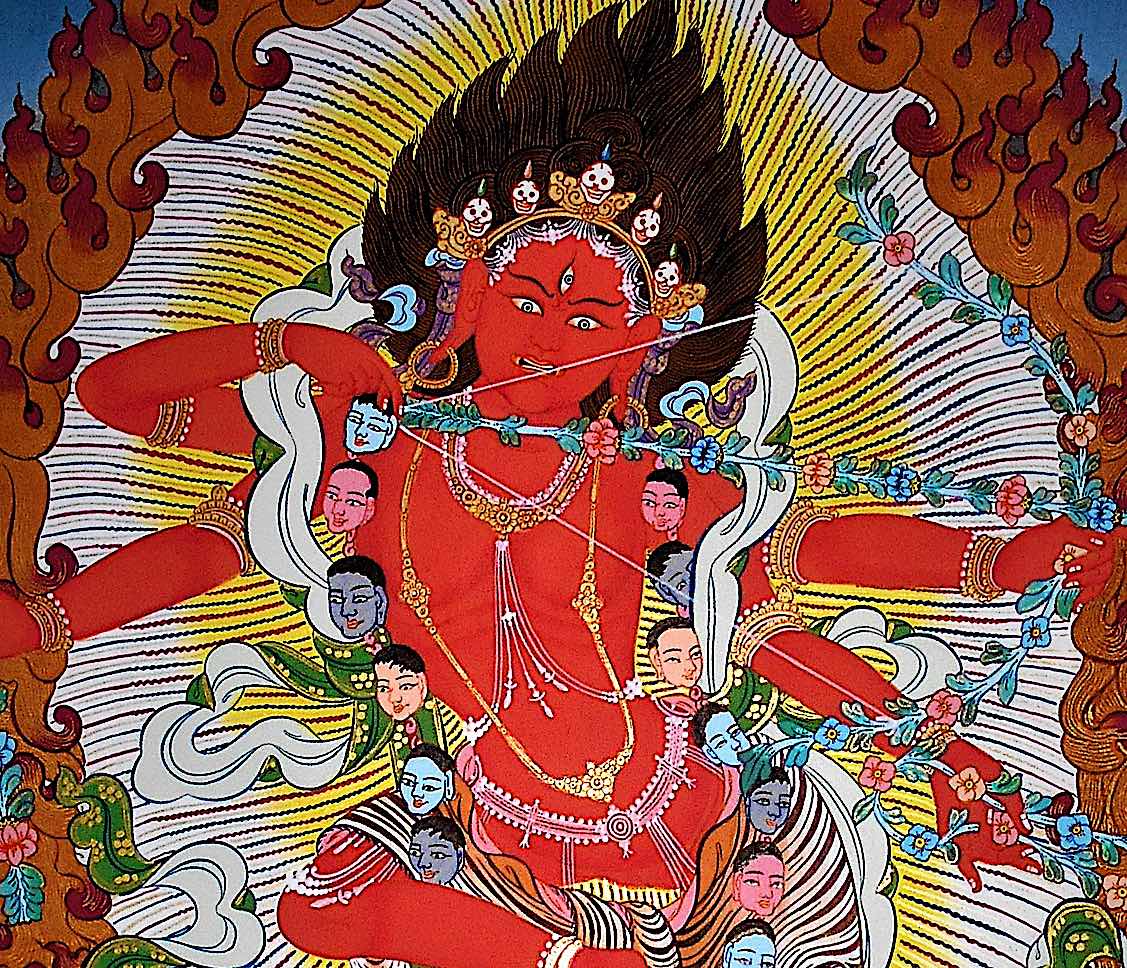
Lotus Family: all the compassionate virtues of Amitabha
Kurukulla, a Highest Yoga Dakini of the Lotus Family, embodies all of the virtues of Amitabha, Chenrezig and Hayagriva. She shares the same seed syllable HRI, the seed syllable of Amitabha and Hayagriva because she is of the same essence at the ultimate level.
As with all Lotus family, her mission is compassion. As a Dakini, she embodies “wisdom.” The two together, as Kurukulla, represent the Enlightened union of Wisdom and Compassion. On a more “mundane” level, she represents the power of love, attraction, youth and magic, subjugation, but, again, for a virtuous purpose. In principle, the same concept (although less mundane) as a celebrity using their beautiful persona to raise awareness of the charity and to attract money and goodwill to the cause — except, more magical, and directed at only Enlightened causes. In the same way that Audrey Hepburn used her presence as a Goodwill Ambassador for UNICEF or Angelina Jolie who became United Nations High Commissioner for Refugees (whatever you think of her, a legend in charity work), or other big names in charity, such as Oprah, Elizabeth Taylor, and J.Lo (Lopez Family Foundation) — Kurukulla uses her exotic beauty and enchanting magic to attract.
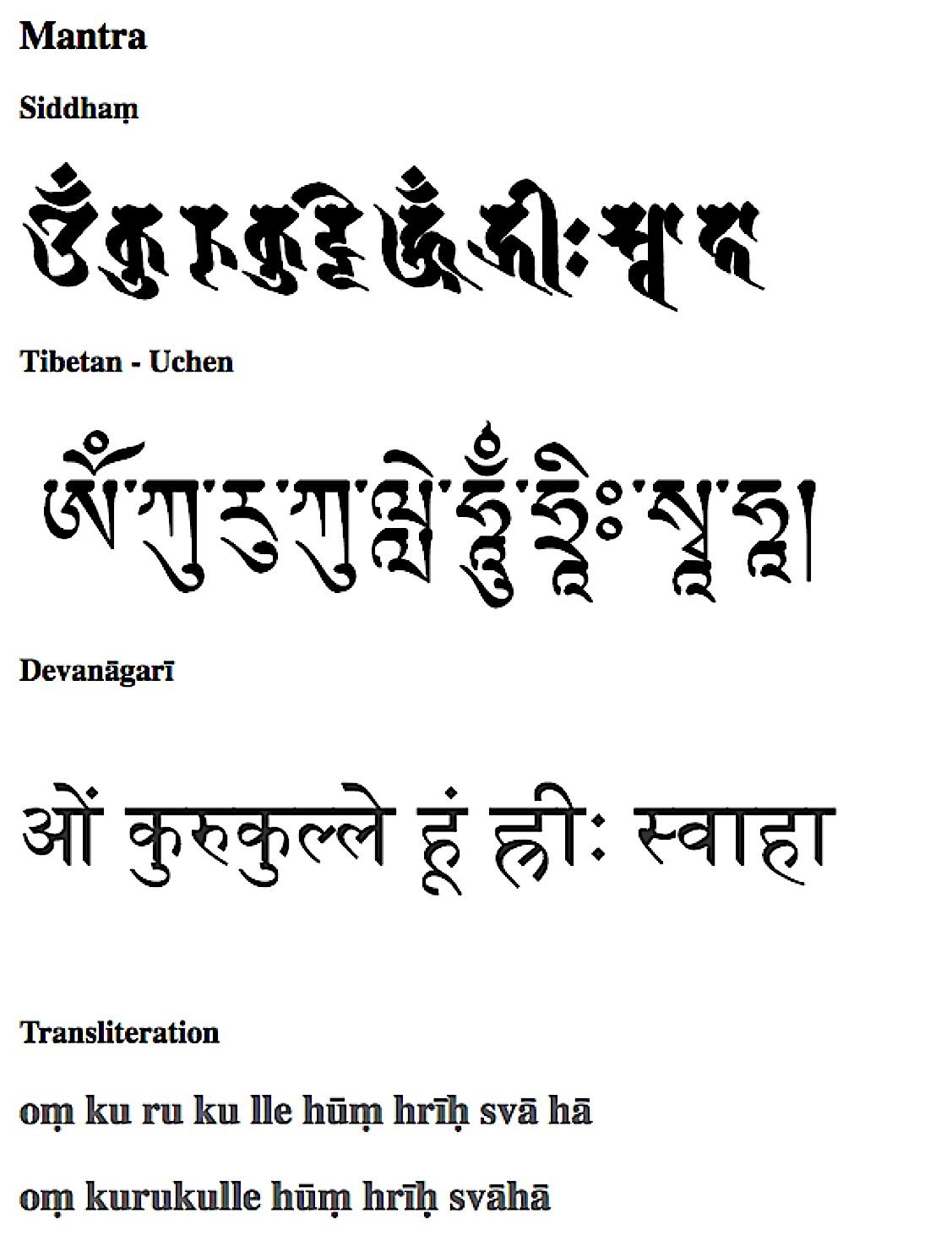
The main mantra of Kurukulla in Sanskrit and Tibetan scripts. From the wonderful site: visiblemantra.org.
Kurukulla Mantra
Although it is recommended that a student has empowerment and “lung” permission to use her mantra, it is a well-known and well-published mantra. For this reason, we reproduce it here, with the caution that her mantra should be used by actual practitioners who have initiation or permission of a qualified teacher.
The essential mantra of Kurukullā is
Oṁ Kurukulle Hrīḥ Svāhā
(Tibetan: ༀ་ཀུ་རུ་ཀུ་ལླེ་ཧྲཱིཿསྭཱ་ཧཱ).
Special Event Notice: On November 30, 2018, for those in the Toronto area, there will be a rare empowerment (initiation) of Kurukulla from H.E. Zasep Rinpoche at Gaden Choling Mahayana Meditation Centre. Details here>>
NOTES
[1] Himilayan Art Resources — Kurukulla >>
The post Kurukulla: the “Diva” Dakini of enlightened magic; the enchantress transforms seduction into ‘the cause of wisdom’ appeared first on Buddha Weekly: Buddhist Practices, Mindfulness, Meditation.
from Buddha Weekly: Buddhist Practices, Mindfulness, Meditation https://ift.tt/2F9CmPi

Post a Comment